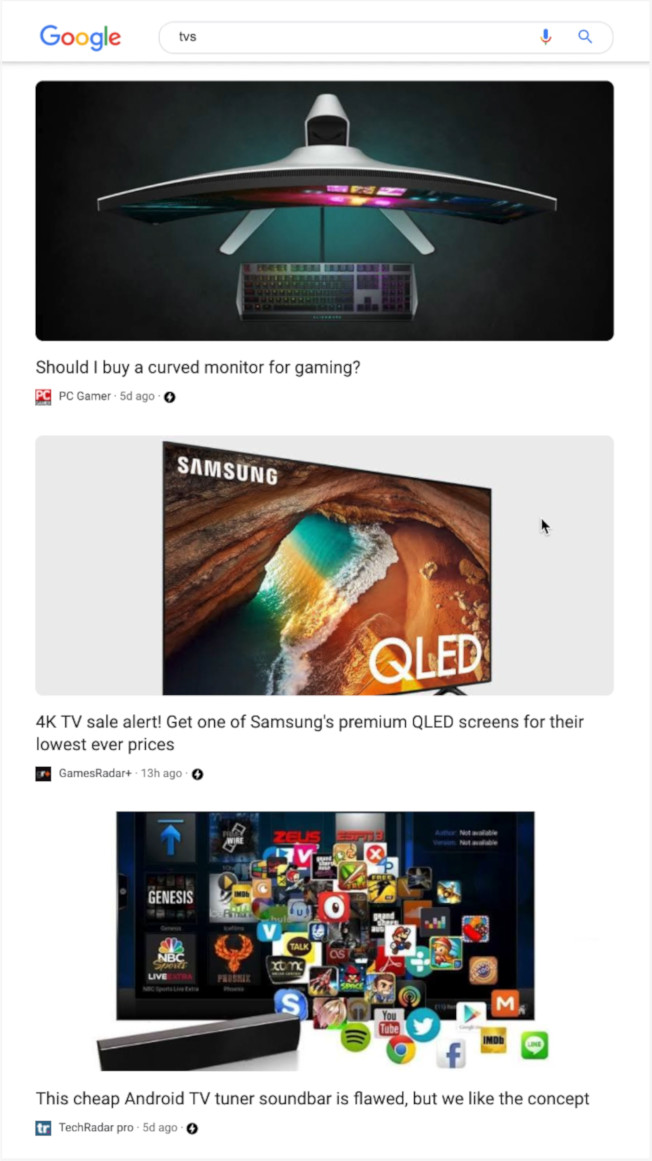
Navigate an unpredictable landscape with actionable, data-driven strategies tailored for your business from the brand down to the local level.

Ah, the illustrious deity that is Google and its faithful servant, the search engine results page (SERP). We bow down to thee and ask that this content may rank highly and claim the glorious throne that is the first results page…
If only a prayer could really earn that top spot on page one! While the actual process may not be as dramatic (or as straightforward), businesses do indeed have to earn Google’s favor to be recognized in search results.
Fortunately, the search giant appears to be focusing its attention on the relationship between SEO and content, presenting a priceless opportunity to combine robust search strategies and amazing content to drive outrageous growth. But what, exactly, has changed?
On the eighth day, Google presented the CRP—the content results page. Now don’t get ahead of yourself: this seems to only amount to a test on Google’s part, with no evidence (yet) that this upgrade may even come to fruition. Nevertheless, the CRP is a positive vision of how content may one day be presented on SERPs.

The larger snippets of content shown, whether photo or video, allow users to get a more comprehensive taste of what they can expect from each given result. Providing more relevant information right off the bat further shortens the time needed for users to find exactly what they want. This, in turn, plays into the idea of “zero click” searches, where marketing effectively begins on the SERP—requiring brands to be more strategic with the information they’re presenting to users before they even reach their sites.
Of course, Google needs to carefully consider how much it can show in SERPs, from both a copyright and website survival standpoint. After all, if users don’t need to go to a website anymore, then most websites—Google’s sole resource—have no reason to exist, which would mean the search engine’s deep fountain of knowledge is slowly turned off. Google must preserve this symbiosis, balancing helping websites generate traffic and helping itself.
If this divine plan becomes reality, it may prove to be another gift bestowed to us by Google’s ongoing quest to optimize search results based on user intent as opposed to keyword matching. This ultimately illustrates the importance of understanding your audience’s user journeys to provide relevance and value at every stage (as explained in our Enterprise-to-Local Playbook). Praise be!

It’s also worth noting that user experience (UX) plays a significant role here. The overall experience that comes from a SERP interaction—leading to a landing page, and then onward to subsequent navigation through the site—can indeed effect rankings. In the end, it all comes back to businesses understanding how to create the best possible experience for their users, starting with an increasingly rich and dynamic presence on the SERP itself.
We’ve always believed in the power of putting users first by effectively integrating SEO and content. But for those who may need some more guidelines, here’s how you can prepare for this anticipated shift:
Subscribe to our monthly newsletter.
What type of content will not only satisfy user intent and interests at each stage of their journey, but also align with your business priorities? Ensure your content is both intriguing and relevant enough that it would generate clicks on a new breed of SERP—and that those clicks are qualified enough to generate measurable sales, leads, and conversions for your business.
What have you already created that is still supported by your latest audience insights? You’ll save time and money by freshening up past content and repurposing it into something new and shiny again! Plus, Google is a kind and benevolent god who will reward relevant new content.
The way you measure performance may have to change as users increasingly consume content directly on the SERP. In a zero-click world, how can you provide enough information to warrant a larger snippet while still drawing users to a landing page? It’s impossible to believe that clicks would ever become completely irrelevant, but we may need to place a larger importance on other metrics, like bounce rate or time on page.
As much as you can try, you can’t give people everything. When you’re analyzing insights, pick out the top trends that will give you the most bang for your buck and roll with those in order to create the optimal content. Having a well-defined content strategy will only help you succeed faster.
Ultimately, you simply won’t rank—let alone have a nice large plot on a more visual type of SERP—unless your search and content tactics are strategically intertwined. But it may be easier than you think to make a case for SEO and content investment, bring the two disciplines closer, and get ahead in Google’s ever-evolving search landscape. In fact, it happens to be a specialty of ours.
Navigate an unpredictable landscape with actionable, data-driven strategies tailored for your business from the brand down to the local level.
Navigate an unpredictable landscape with actionable, data-driven strategies tailored for your business from the brand down to the local level.
Navigate an unpredictable landscape with actionable, data-driven strategies tailored for your business from the brand down to the local level.
Subscribe to our monthly newsletter.